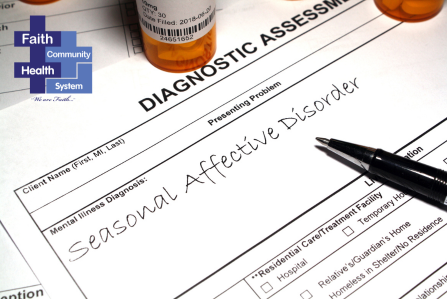It’s that time of year again, when daylight hours dwindle, temperatures plummet, and so many of us experience the return of the “winter blues.”
“Take comfort in knowing that what you’re experiencing is very real and you’re not alone. Let’s identify if what you’re feeling is a case of Seasonal Affective Disorder, appropriately known as SAD,” suggests Shawn White, MD, Chief Medical Officer of Faith Community Health System. “Let’s help you get through this seasonal affliction.”
SAD is a form of depression that can affect sufferers in any number of ways. Symptoms typically appear in the fall, when days become shorter. Described by many as “the blues,” SAD continues throughout the winter months. Come springtime, the symptoms generally resolve.
It’s an unpleasant cycle to endure, year after year, but keep reading for tips on how to manage your SAD and alleviate symptoms.
Symptoms of SAD may include:
● Feeling sad or lethargic on most days
● Not enjoying your interests, like reading, crafts or watch sports
● Low energy
● Sleeping too much and/or have trouble waking up
● Craving carbs and sweets, eating too much and gaining weight
● Difficulty concentrating
● Feeling hopeless
● In extreme cases, having thoughts of not wanting to live
Recognizing the symptoms of SAD is the first step toward managing it. While there are steps you can take to feel better, if your SAD symptoms are affecting your work and home life, seek the expertise of your family doctor, like Dr. White, or any of the skilled medical professionals at Faith.
Diagnosing SAD
SAD is not always easy to definitively diagnose. Dr. White says that getting a complete evaluation, including a physical exam along with lab tests, can rule out any underlying physical issues you may have.
“Once we get a full understanding of what’s going on and rule out a physical issue, we can explore all the various treatment options for SAD and determine what is best for each person,” Dr. White says.
Treatment Options
The good news is that for mild cases of SAD, your symptoms will typically resolve in the spring, when daylight hours are longer and temperatures warm up.
But for individuals whose symptoms are affecting their day-to-day lives right now, spring is a very long time away!
There are treatment options for SAD. In fact, Dr. White suggests:
● Light Therapy – Also known as phototherapy, light therapy involves sitting in front of a special light box when you wake up. It’s intended to mimic natural light and has been shown to change brain chemicals linked to mood. You’ll see results in just a few days. This treatment is not recommended for those with bipolar disorder.
● Psychotherapy – We know this as talk therapy. Your mental health professional can help you learn ways to cope with your SAD symptoms and set you on a course to build healthy behaviors that will be a benefit, all year long.
● Medication – Some antidepressant medications have been shown to help with the symptoms of SAD. If your bout with SAD is something you deal with every year, your mental health practitioner may recommend you start treatment in late summer or early fall, before the onset of seasonal symptoms.
Managing Your Symptoms
There are several steps you can take, to increase your chances for success in overcoming this unpleasant syndrome. Make these healthy habits that you can enjoy, all year long.
Free and easy steps you can take include:
● Bring in the light – Open your window shades, blinds and curtains. Say no to blackout shades. Sit closer to windows at home or in the office
● Step outside – Absorb some of that delicious Vitamin D. Take a walk at lunch, sit on a bench and bask in the sunlight, throw a frisbee for the dog. Natural light therapy is most effective within an hour or two of waking up, and is still beneficial, even on cold and cloudy days.
● Add exercise – A brisk walk outside is a great way to banish the blues. Bring a friend, and make it a social event. Feeling fit and healthy is a great way to combat SAD.
You can join the Swan Family Wellness Center in Jacksboro. It’s adjacent to Faith Community Hospital and offers members access to a beautiful pool, a schedule of fun classes and a full range of workout equipment. Call (940) 567-6633 for more information.
● Schedule sleep – You’ve heard it said, time and time again. Schedule your sleep so that you wake up and go to bed around the same time, every day… that counts for weekends, too.
“This is a healthy strategy for anyone, but even more important for SAD sufferers,” Dr. White adds, noting people with SAD should also avoid napping and oversleeping.
SAD is unpleasant at best, debilitating at worst. Today’s the day to take control of your seasonal blues, by making just a few minor adjustments to your daily routine that’ll help to ease your symptoms and improve your overall health. Spring is coming!

